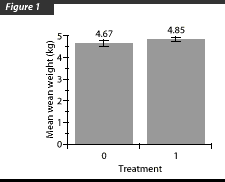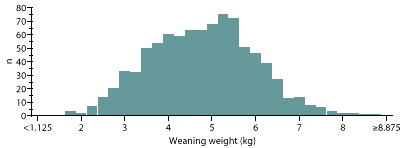 This month's "What's your interpretation"
is the first of a series that will explain how to select the appropriate
statistical tests for various types of data.
This month's "What's your interpretation"
is the first of a series that will explain how to select the appropriate
statistical tests for various types of data.
What's your interpretation? |

 This month's "What's your interpretation"
is the first of a series that will explain how to select the appropriate
statistical tests for various types of data.
This month's "What's your interpretation"
is the first of a series that will explain how to select the appropriate
statistical tests for various types of data.
The figure on the front represents the weaning weights for the pigs in the treatment and control groups from a trial in which:
For the purposes of this explanation, we will assume that:
Statistics can tell us whether the average weaning weight of the controls is "significantly" different than the average of the treated pigs--i.e., whether the difference we observe is due to the treatment or due merely to chance.
For any type of statistical test, the first step is to identify the outcome (or "dependent") variable. Simply put, the outcome variable is the variable of interest. The easiest way to determine which variable is your outcome variable is to ask, "what are we measuring?" In the case of our study above, we measured the weaning weights of the pigs, so weaning weight is our outcome variable.
Outcome variables fall into one of three categories. Because the different variable types have different mathematical properties, correctly determining what type of variable we are working with is a key factor in deciding which statistical test is appropriate. The three types of outcome variables include:
Obviously, these three types of variables all have specific, discrete mathematical properties and expected distributions. Statistical tests are based on these expected distributions. Therefore, you must correctly indentify the variable type of your outcome variable.
In our next issue, we will discuss another crucial decision node in determining the appropriate statistical test for a set of data: whether or not those data are normally distributed.
Kumar S, Dewey CE, Friendship RM, Shewen P. Improved daily gain and disease resistance using levamisole as an immunomodulator. Proc AASP Ann Meet. 1998:379-385.
Snedecor GW, Cochran WG. Statistical Methods. Iowa State University Press. Ames, Iowa. 7th Edition. 1980.










The AASV website and The Journal of Swine Health and Production are made possible by the generous support of the AASV Industry Support Council, including: .
Copyright (C) 1996-2002 American Association of Swine Veterinarians. Please send your suggestions about this site to Dave Brown, webmaster@aasv.org.
This page last updated April 19, 2012.